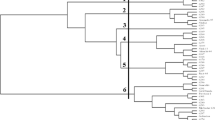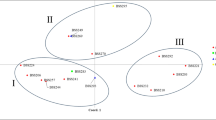Abstract
Erianthus arundinaceus, a member of the Saccharum complex, is of interest as a potential resource for sugarcane improvement and as a bioenergy crop. Genetic analyses of germplasm collections of E. arundinaceus are being used increasingly. To expand the genomic resources in E. arundinaceus, we aimed at developing simple sequence repeat markers. Using pyrosequencing on the 454 GS FLX system, we sequenced genomic DNA from “JW630” collected in Japan. A total of 1682 candidate loci were used to design the primers, and 1234 primer pairs amplified fragments of the expected size in the primer screening with three wild E. arundinaceus accessions (JW630, “JW4,” and “IJ76-349”). The efficiency of genotyping was validated with a subset of 174 primer pairs and 8 E. arundinaceus accessions. Of these primer pairs, 171 amplified fragments in all accessions tested and 162 detected polymorphic loci. The average values of genetic parameters were estimated as 0.30 (range, 0.09–0.49) for polymorphic information content, 1.65 (0.00–5.87) for marker index, and 2.78 (0.00–8.75) for resolving power. Using these parameters, we selected 61 primer pairs with large discriminatory power for the analyzed loci. Of the 174 primer pairs, 45 (25.9%) were also applicable to Saccharum and 33 (19.0%) to Miscanthus species. These markers would provide a valuable tool for estimating genetic diversity and constructing linkage maps in E. arundinaceus, which would be useful for genetic study and breeding.


Similar content being viewed by others
References
Abdelkrim J, Robertson BC, Stanton JA, Gemmell NJ (2009) Fast cost-effective development of species-specific microsatellite markers by genomic sequencing. BioTechniques 46:185–192. doi:10.2144/000113084
Altschul SF, Madden TL, Schäffer AA, Zhang J, Zhang Z, Miller W, Lipman DJ (1997) Gapped BLAST and PSI-BLAST: a new generation of protein database search programs. Nucl Acid Res 25:3389–3402. doi:10.1093/nar/25.17.3389
Amalraj VA, Balasundaram N (2006) On the taxonomy of the members of ‘Saccharum complex’. Genet Resour Crop Evol 53:35–41. doi:10.1007/s10722-004-0581-1
Becher SA, Steinmetz K, Weising K, Boury S, Peltier D, Renou JP, Kahl G, Wolff K (2000) Microsatellites for cultivar identification in Pelargonium. Theorl Appl Genet 101:643–651. doi:10.1007/s001220051526
Bennett MD, Bhandol P, Leitch IJ (2000) Nuclear DNA amounts in angiosperms and their modern uses-807 new estimates. Ann Bot 86:859–909. doi:10.1006/anbo.2000.1253
Berding N, Roach BT (1987) Germplasm collection, maintenance, and use. In: Heinz DJ (ed) Sugarcane improvement through breeding. Elsevier Press, Amsterdam, pp 143–210
Besse P, Mcintyre CL, Berding N (1996) Ribosomal DNA variation in Erianthus, a wild sugarcane relative (Andropogoneae-Saccharinae). Theor Appl Genet 92:733–743. doi:10.1007/BF00226096
Besse P, McIntyre CL, Berding N (1997) Characterisation of Erianthus sect Ripidium and Saccharum germplasm (Andropogoneae–Saccharinae) using RFLP markers. Euphytica 93:283–292. doi:10.1023/A:1002940701171
Cai Q, Aitken KS, Fan YH, Piperidis G, Liu XL, McIntyre CL, Huang XQ, Jackson P (2012) Assessment of the genetic diversity in a collection of Erianthus arundinaceus. Genet Resour Crop Evol 59:1483–1491. doi:10.1007/s10722-011-9776-4
Cardle L, Ramsay L, Milbourne D, Macaulay M, Marshall D, Waugh R (2000) Computational and experimental characterization of physically clustered simple sequence repeats in plants. Genetics 156:847–854
Celik I, Gultekin V, Allmer J, Doganlar S, Frary A (2014) Development of genomic simple sequence repeat markers in opium poppy by next-generation sequencing. Mol Breed 34:323–334. doi:10.1007/s11032-014-0036-0
Chen J-W, Lao F-Y, Chen C-W, Deng H-H, Liu R, He H-Y, Fu C, Chen Y-S, Liu F-Y, Li Q-W, Jackson P, Aitken K (2015) DNA marker transmission and linkage analysis in populations derived from a sugarcane (Saccharum spp.) x Erianthus arundinaceus hybrid. PLoS One 10:e0128865. doi:10.1371/journal.pone.0128865
Cordeiro GM, Casu R, McIntyre CL, Manners JM, Henry RJ (2001) Microsatellite markers from sugarcane (Saccharum spp.) ESTs cross transferable to erianthus and sorghum. Plant Sci 160:1115–1123. doi:10.1016/S0168-9452(01)00365-X
D’Hont A, Rao PS, Feldmann P, Grivet L, Islam-Faridi N, Taylor P, Glaszmann JC (1995) Identification and characterisation of sugarcane intergeneric hybrids, Saccharum officinarum x Erianthus arundinaceus, with molecular markers and DNA in situ hybridisation. Theor Appl Genet 91:320–326. doi:10.1007/BF00220894
Daniels J, Roach BT (1987) Taxonomy and evolution. In: Heinz DJ (ed) Sugarcane improvement through breeding. Elsevier, New York, pp 7–84
Ellis JR, Burke JM (2007) EST-SSR as a resource for population genetic analysis. Heredity 99:125–132. doi:10.1038/sj.hdy.6801001
de Jesus ON, e Silva SDO, Amorim EP, Ferreira CF, de Campos JMS, de Gaspari Silva G, Figueira A (2013) Genetic diversity and population structure of Musa accessions in ex situ conservation. BMC Plant Biol 13:41. doi:10.1186/1471-2229-13-41
Faircloth BC (2008) MSATCOMMANDER: detection of microsatellite repeat arrays and automated, locus-specific primer design. Mol Ecol Res 8:92–94. doi:10.1111/j.1471-8286.2007.01884.x
Haq SU, Kumar P, Singh RK, Verma KS, Bhatt R, Sharma M, Kachhwaha S, Kothari SL (2016) Assessment of functional EST-SSR markers (sugarcane) in cross-species transferability, genetic diversity among Poaceae plants, and bulk segregation analysis. Genet Res International 2016:7052323. doi:10.1155/2016/7052323
Hodkinson TR, Chase MW, Lledó MD, Salamin N, Renvoize SA (2002) Phylogenetics of Miscanthus, Saccharum and related genera (Saccharinae, Andropogoneae, Poaceae) based on DNA sequences from ITS nuclear ribosomal DNA and plastid trnL intron and trnL-F intergenic spaces. J Plant Res 115:381–392. doi:10.1007/s10265-002-0049-3
Jackson P, Henry RJ (2011) Erianthus. In: Kole C (ed) Wild crop relatives: genomic and breeding resources: industrial, chapter 5. Springer, Berlin, Heidelberg, pp 97–109. doi:10.1007/978-3-642-21102-7_5
James BT, Chen C, Rudolph A, Swaminnathan K, Murray JE, Na J-K, Spence AK, Smith B, Hudson ME, Moose SP, Ming R (2012) Development of microsatellite markers in autopolyploid sugarcane and comparative analysis of conserved microsatellites in sorghum and sugarcane. Mol Breed 30:661–669. doi:10.1007/s11032-011-9651-1
Kantety RV, Rota ML, Matthew DE, Scorrells ME (2002) Data mining for simple sequence repeats in expressed sequence tags from barley, maize, rice, sorghum and wheat. Plant Mol Biol 48:501–510. doi:10.1023/A:1014875206165
La Rota M, Kantety RV, Yu JK, Sorrells ME (2005) Nonrandom distribution and frequencies of genomic and EST-derived microsatellite markers in rice, wheat, and barley. BMC Genomics 6:23. doi:10.1186/1471-2164-6-23
Lagercrantz U, Ellegren H, Andersson L (1993) The abundance of various polymorphic microsatellite motifs differs between plants and vertebrates. Nucl Acids Res 21:1111–1115. doi:10.1093/nar/21.5.1111
Lian C, Oishi R, Miyashita N, Nara K, Nakaya H, Wu B, Zhou Z, Hogetsu T (2003) Genetic structure and reproduction dynamics of Salix reinii during primary succession on Mount Fuji, as revealed by nuclear and chloroplast microsatellite analysis. Mol Ecol 12:609–618. doi:10.1046/j.1365-294X.2003.01756.x
Liao WJ, Zhu BR, Zeng YF, Zhang DY (2008) TETRA: an improved program for population genetic analysis of allotetraploid microsatellite data. Mol Ecol Resour 8:1260–1262. doi:10.1111/j.1755-0998.2008.02198.x
Lowrance R, Anderson W, Miguez F, Strickland T, Knoll J, Sauer T (2010) Sustainable feedstocks for advanced biofuels. In: Braun R, Karlen D, Johnson D (eds) Landscape management and sustainable feedstock production: enhancing net regional primary production while minimizing externalities, chapter 1. Soil and Water Conservation Society, Los Angeles, pp 1–19
Mislevy P, Martin FG, Adjei MB, Miller JD (1997) Harvest management effects on quantity and quality of Erianthus plant morphological components. Biomass Bioenergy 13:51–58. doi:10.1016/S0961-9534(97)00023-8
Mukherjee SK (1957) Origin and distribution of Saccharum. Bot Gaz 119:55–61
Murray MG, Thompson WF (1980) Rapid isolation of high-molecular-weight plant DNA. Nuc Acids Res 8:4321–4325. doi:10.1093/nar/8.19.4321
Nair NV, Selvi A, Sreenivasan TV, Pushpalatha KN, Mary S (2005) Molecular diversity among Saccharum, Erianthus, Sorghum, Zea and their hybrids. Sugar Tech 7:55–59. doi:10.1007/BF02942418
Nakagawa H (2012) Genetic resources and breeding of tropical grasses, forages—Apomixis—biofuel feedstocks. J Dev Sus Agr 7:1–8. doi:10.11178/jdsa.7.1
Nakagawa H, Sakai M, Harada T, Ichinose T, Takeno K, Matsumoto S, Kobayashi M, Matsumoto K, Yakushido K (2011) Biomethanol production from forage grasses, tree, and crop residues. In: dos Santos Bernardes MA (ed) Biofuel’s engineering process technology, chapter 30. InTech, Rijeka, Croatia, pp 715–732. doi:10.5772/18168
Pinto LR, Oliveira KM, Marconi T, Garcia AAF, Ulian EC, DeSouza AP (2006) Characterization of novel sugarcane expressed sequence tag microsatellites and their comparison with genomic SSRs. Plant Breed 125:378–384. doi:10.1111/j.1439-0523.2006.01227.x
Piperidis G, Christopher MJ, Carroll BJ, Berding N, D’Hont A (2000) Molecular contribution to selection of intergeneric hybrids between sugarcane and the wild species Erianthus arundinaceus. Genome 43:1033–1037. doi:10.1139/g00-059
Powell W, Margenta M, Andre C, Hanfrey M, Vogel J, Tingey S, Rafalski A (1996) The comparison of RFLP, RAPD, AFLP and SSR (microsatellite) markers for germplasm analysis. Mol Breed 2:225–238. doi:10.1007/BF00564200
Prevost A, Wilkinson MJ (1999) A new system of comparing PCR primers applied to ISSR fingerprinting of potato cultivars. Theor Appl Genet 98:107–112. doi:10.1007/s001220051046
Ravishankar KV, Dinesh MR, Nischita P, Sandya BS (2015) Development and characterization of microsatellite markers in mango (Mangifera indica) using next-generation sequencing technology and their transferability across species. Mol Breed 34:93–105. doi:10.1007/s11032-0150289-2
Roa AC, Chavarriaga-Aguirre P, Duque MC, Maya MM, Bonierbale MW, Iglesias C, Tohme J (2000) Cross-species amplification of cassava (Manihot esculenta) (Euphorbiaceae) microsatellites: allelic polymorphism and degree of relationship. Am J Bot 87:1647–1655
Roldan-Ruiz I, Dendauw JE, Van Bockstaele E, Depicker A, Loose M (2000) AFLP markers reveal high polymorphic rates in ryegrasses (Lolium spp.) Mol Breed 6:125–126. doi:10.1023/A:1009680614564
Saha MC, Mian R, Zwonitzer JC, Chekhovskiy K, Hopkins AA (2005) An SSR- and AFLP-based genetic linkage map of tall fescue (Festuca arundinacea Schreb.) Theor Appl Genet 110:323–336. doi:10.1007/s00122-004-1843-1
Schuelke M (2000) An economic method for the fluorescent labeling of PCR fragments. Nature Biotech 18:233–234. doi:10.1038/72708
Selvi A, Nair NV, Noyer JL, Singh NK, Balasundaram N, Bansal KC, Koundal KR, Mohapatra T (2006) AFLP analysis of the phenetic organization and genetic diversity in the sugarcane complex, Saccharum and Erianthus. Genet Resour Crop Evol 53:831–842. doi:10.1007/s10722-004-6376-6
Singh RK, Jena SN, Khan S, Yadav S, Banarjee N, Raghuvanshi S, Bhardwaj V, Dattamajumder SK, Kapur R, Solomon S, Swapna M, Srivastava S, Tyagi AK (2013) Development, cross-species/genera transferability of novel EST-SSR markers and their utility in revealing population structure and genetic diversity in sugarcane. Gene 524:309–329. doi:10.1016/j.gene.2013.03.125
Tian AG, Wang J, Cui P, Han YJ, Xu H, Cong LJ, Huang XG, Wang XL, Jiao YZ, Wang BJ, Wang YJ, Zhang JS, Chen SY (2004) Characterization of soybean genomic features by analysis of its expressed sequence tags. Theor Appl Genet 108:903–913. doi:10.1007/s00122-003-1499-2
Tóth G, Gáspári Z, Jurka J (2000) Microsatellites in different eukaryotic genomes: survey and analysis. Genome Res 10:967–981. doi:10.1101/gr.10.7.967
Trapnell DW, Hamrick JL, Parker KC, Braungart KW, Glenn TC (2011) Evaluating the utility of microsatellites for investigations of autopolyploid taxa. J Hered 102:473–478. doi:10.1093/jhered/esr045
Tsuruta S, Ebina M, Kobayashi M, Hattori T, Terauchi T (2012) Analysis of genetic diversity in the bioenergy plant Erianthus arundinaceus (Poaceae: Andropogoneae) using amplified fragment length polymorphism markers. Grassl Sci 58:174–177. doi:10.1111/j.1744-697X.2012.00258.x
Varshney RK, Graner A, Sorrells ME (2005) Genic microsatellite markers in plants: features and application. Trends Biotechnol 23:48–55. doi:10.1016/j.tibtech.2004.11.005
Yan J, Zhang J, Sun K, Chang D, Bai S, Shen Y, Huang L, Zhang J, Zhang Y, Dong Y (2016) Ploidy level and DNA content of Erianthus arundinaceus as determined by flow cytometry and the association with biological characteristics. PLoS One 11:e0151948. doi:10.1371/journal.pone. 0151948
Zhang HY, Li FS, Liu XZ, He LL, Yang QH, He SC (2008) Analysis of genetic variation in Erianthus arundinaceus by random amplified polymorphic DNA markers. African J Biotech 7:3414–3418
Zhang J, Yan J, Zhang Y, Ma X, Bai SQ, Wu Y, Dao Z, Li D, Zhang C, Zhang Y, You M, Yang F, Zhang J (2013) Molecular insights of genetic variation in Erianthus arundinaceus populations native to China. PLoS One 8:e80388. doi:10.1371/journal.pone.0080388
Zhang JB, Yan JJ, Shen XY, Bai SQ, Li DX, Zhang Y, You MH (2017) Development of polymorphic microsatellite markers and their use in collections of Erianthus arundinaceus in China. Grassl Sci 63:54–60. doi:10.1111/grs.12148
Acknowledgements
We thank the staff of the Forage Plant Breeding and Genetics group at NARO-ILGS who provided technical assistance with the experiments and the staff of the sugarcane improvement project team at JIRCAS-TARF for their great help and their contribution to the data analysis. This study was supported by research grants from the National Agriculture and Food Research Organization (no. 220a0) and the Japan International Research Center for Agricultural Sciences (no. 001750).
Author information
Authors and Affiliations
Corresponding author
Rights and permissions
About this article
Cite this article
Tsuruta, Si., Ebina, M., Kobayashi, M. et al. Development and validation of genomic simple sequence repeat markers in Erianthus arundinaceus . Mol Breeding 37, 71 (2017). https://doi.org/10.1007/s11032-017-0675-z
Received:
Accepted:
Published:
DOI: https://doi.org/10.1007/s11032-017-0675-z




